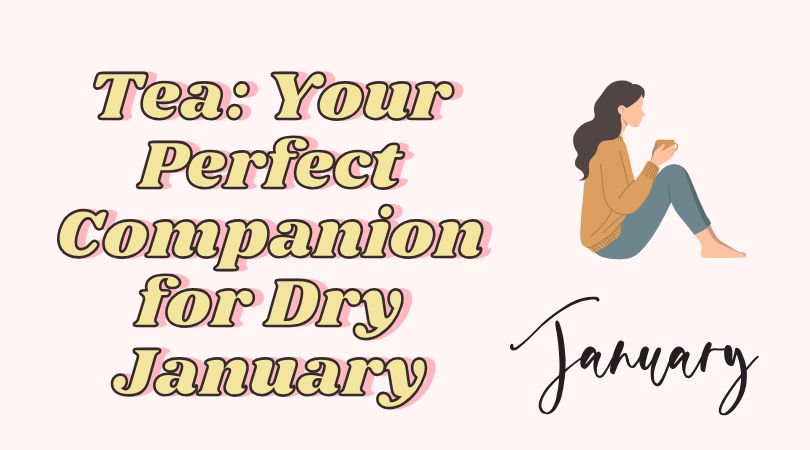
As millions embrace the personal challenge of Dry January, many find themselves seeking alternatives to their usual alcoholic beverages. Tea is nature’s sophisticated and versatile drink that offers hydration and a world of flavors, rituals, and wellness benefits that make it the perfect companion for your alcohol-free journey.
Why Tea Works as an Alcohol Alternative
The ritual of preparing and sipping tea can effectively replace the psychological comfort many associate with drinking alcohol. Like wine appreciation, tea culture celebrates variety, complexity, and the art of mindful consumption. Different teas offer unique flavor profiles, from delicate white teas to robust and earthy shou puerh, providing the same opportunity for taste exploration that wine enthusiasts enjoy.
Tea contains L-theanine, an amino acid that promotes relaxation without sedation – a natural way to unwind after a long day. Combined with its modest caffeine content, tea provides a balanced energy boost while maintaining mental clarity, unlike the foggy aftermath of alcohol consumption.

Exploring Tea Varieties for Different Times of Day
Morning Motivation
Start your day with an English Breakfast or Earl Grey tea. These black teas provide a robust caffeine kick comparable to coffee but with a smoother energy curve thanks to L-theanine. The citrusy notes in Earl Grey can be particularly uplifting, helping to establish a positive morning routine.
Afternoon Refreshment
For midday sipping, green teas like Sencha or Jasmine Pearl offer a lighter caffeine content with abundant antioxidants. These teas can help maintain focus and productivity without the mid-afternoon crash often associated with coffee or the temptation of a happy hour drink. Oolong is also a favorite of mine for this time of day.
Evening Relaxation
As day turns to night, herbal infusions become your best friend. Chamomile, lavender, and valerian root teas provide natural relaxation properties that can replace the wind-down effect people often seek in alcohol. Rooibos is naturally caffeine-free and offers a rich, slightly sweet flavor that can satisfy cravings for more complex beverages. Tulsi, also known as Holy Basil, is another one of my go tos for nighttime sipping.
Creating Tea Rituals and Mocktails
Transform your tea experience by creating new rituals that rival the sophistication of cocktail hour. Try these approaches:
Cold-brew your favorite teas and serve them in wine glasses with fresh fruit garnishes. Steep hibiscus tea with fresh berries and serve it over ice in a champagne flute for a festive, alcohol-free alternative to sparkling wine.
Experiment with tea mocktails by combining different teas with sparkling water, fresh juices, and herbs. A mint-infused green tea with lime and soda water can become your new favorite mojito alternative.

You can also find several tasty recipes in my book, The Tea Recipe Book.
Health Benefits Beyond Sobriety
Choosing tea during Dry January offers numerous health benefits that extend beyond avoiding alcohol. Regular tea consumption has been linked to improved heart health, better digestion, and enhanced immune function. Tea also contains polyphenols and antioxidants that help combat inflammation and support overall wellness.
The hydrating properties of tea also help counter the dehydrating effects of alcohol you might have experienced during the holiday season. This improved hydration can lead to better skin health, increased energy levels, and improved cognitive function.
Economic Benefits
An often-overlooked advantage of switching to tea is the financial benefit. While premium teas exist, even the finest loose-leaf varieties typically cost less per serving than alcoholic beverages. The money saved during Dry January can be substantial, especially for those who frequently enjoy wines or craft cocktails.
Building Sustainable Habits
While Dry January lasts only a month, the tea habits you develop can become valuable tools for more mindful drinking throughout the year. Many people find that after discovering the world of premium teas, they naturally reduce their alcohol consumption even after January ends.
Consider using this month to build a collection of favorite teas and establish new routines around tea consumption. Whether it’s a morning meditation with matcha or an evening wind-down with peppermint tea, these rituals can provide structure and comfort long after Dry January concludes.
Getting Started
Begin your tea journey by investing in a few key items: a variable temperature kettle (different teas require different water temperatures), a selection of quality loose-leaf teas, and something to brew them in. I recommend starting with a stainless steel infuser basket that can be used with any cup or teapot you already have. Visit local tea shops or explore online retailers that offer sample sizes, allowing you to discover your preferences without committing to large quantities.
Remember that, like wine, tea appreciation develops over time. Start with more accessible varieties and gradually explore more complex options as your palate evolves. Join online tea communities or local tea-tasting events to expand your knowledge and connect with others on similar journeys. My beginner’s guide to tea is a great place to learn the basics.
As you navigate Dry January, let tea be your guide to discovering that sobriety doesn’t mean sacrificing flavor, ritual, or sophistication. The world of tea offers endless possibilities for exploration, relaxation, and mindful consumption – making it not just a temporary substitute, but potentially a life-enriching discovery that extends far beyond January.
What tea will you try during Dry January? I’d love to hear from you in the comments below!
Help Support This Site

Support my work in tea by joining my Patreon community. For $2-$5 a month you’ll receive access to exclusive behind-the-scenes content, my private Discord server, surprise quarterly packages, and more!

